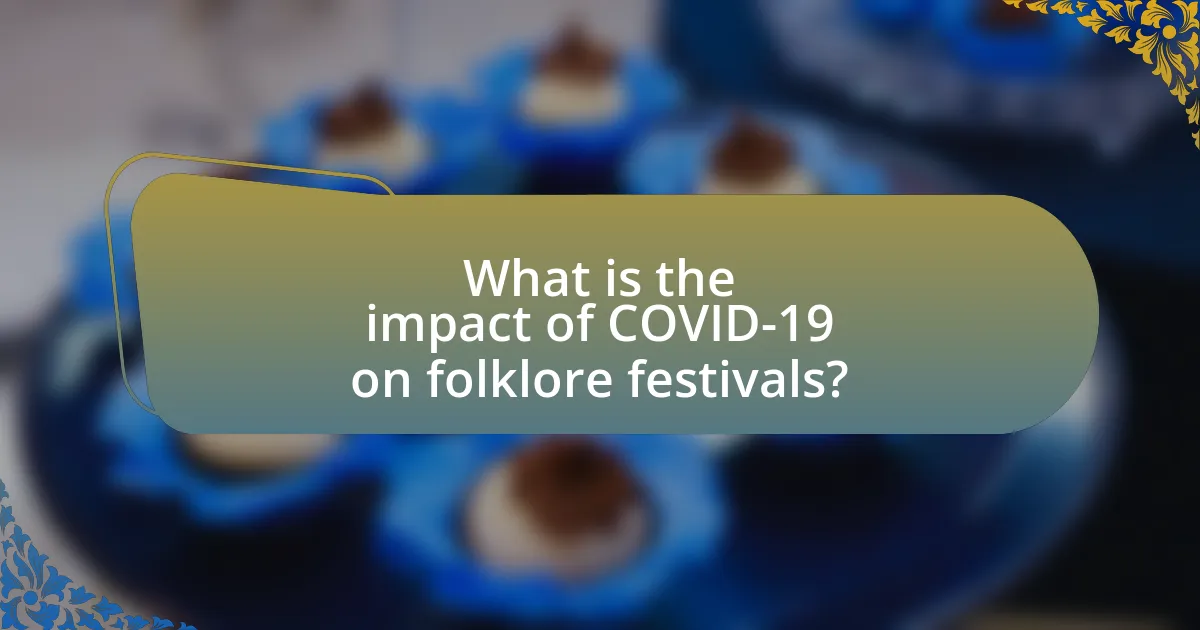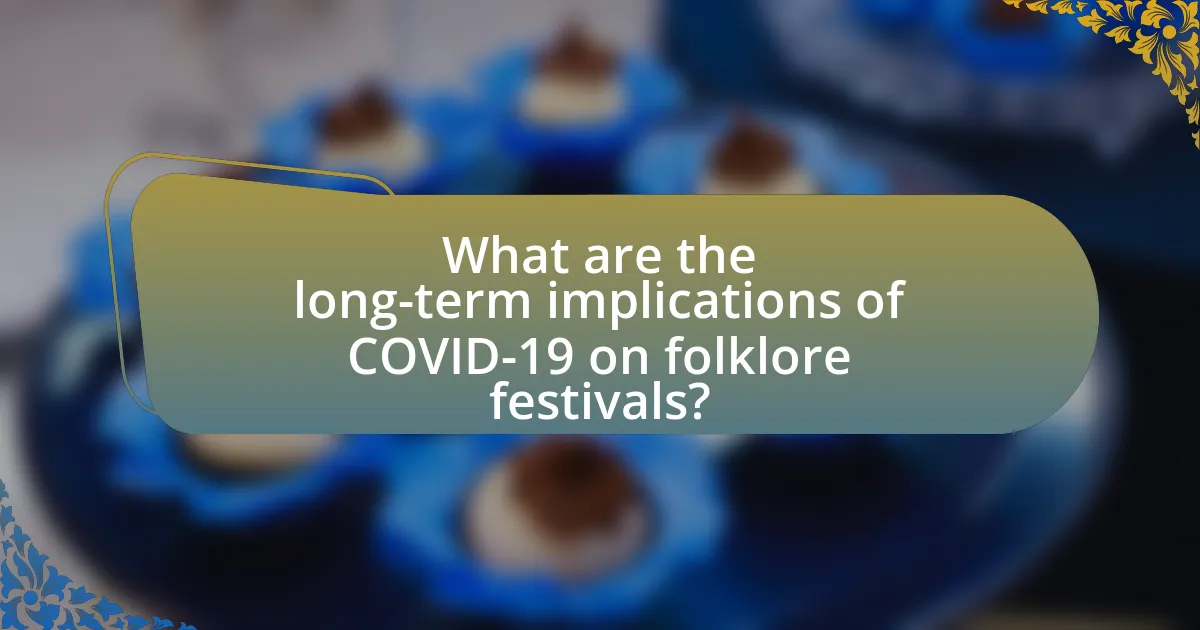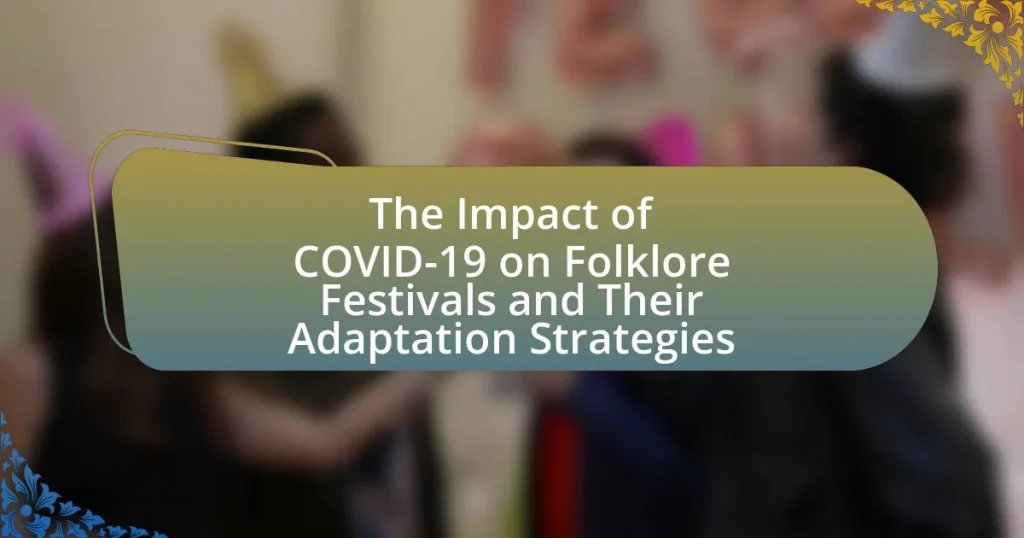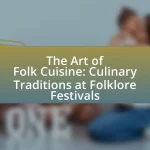The article examines the significant impact of COVID-19 on folklore festivals globally, highlighting disruptions such as cancellations, reduced attendance, and a shift to virtual formats. It details how local governments implemented restrictions on public gatherings, leading to financial losses for many festivals and challenges in scheduling and organization. The article also explores the adaptations made by festivals, including the incorporation of digital elements and innovative strategies to engage audiences, as well as the long-term implications for festival organization and audience expectations in a post-pandemic world. Key lessons on community engagement and resilience are also discussed, emphasizing the importance of adaptability in preserving cultural traditions during crises.

What is the impact of COVID-19 on folklore festivals?
COVID-19 significantly disrupted folklore festivals worldwide, leading to cancellations, reduced attendance, and a shift to virtual formats. For instance, many festivals that traditionally attracted large crowds were either postponed or held online to comply with health guidelines, resulting in a loss of cultural exchange and economic revenue. According to a report by the National Endowment for the Arts, 95% of arts organizations, including folklore festivals, reported financial losses due to the pandemic, highlighting the economic impact. Additionally, the social aspect of these festivals, which fosters community bonding and cultural preservation, was severely affected, as gatherings were restricted.
How did COVID-19 affect the scheduling and organization of folklore festivals?
COVID-19 significantly disrupted the scheduling and organization of folklore festivals by leading to widespread cancellations and postponements. Many festivals, which typically rely on large gatherings, faced restrictions on crowd sizes and health protocols that made traditional formats unfeasible. For instance, in 2020, numerous festivals across the globe, such as the Edinburgh Festival Fringe and the National Folk Festival in Australia, were either canceled or moved to virtual platforms, reflecting a shift in how these events were organized. This adaptation to online formats allowed some festivals to continue, but it fundamentally changed the nature of participation and engagement, as seen in the increased use of live-streaming and digital interactions to reach audiences.
What were the immediate changes made to festival dates and locations?
Immediate changes to festival dates and locations included the postponement or cancellation of numerous events due to COVID-19 restrictions. For instance, many folklore festivals that typically occur in the summer months were rescheduled to later in the year or moved to virtual formats to comply with health guidelines. Specific examples include the cancellation of the 2020 National Folk Festival in Australia and the postponement of the 2020 Smithsonian Folklife Festival in the United States, which were both directly impacted by the pandemic’s restrictions on large gatherings. These adjustments were necessary to ensure the safety of participants and attendees while adhering to government mandates.
How did local governments respond to the pandemic regarding public gatherings?
Local governments responded to the pandemic by implementing restrictions on public gatherings to mitigate the spread of COVID-19. These measures included limiting the number of attendees at events, enforcing social distancing guidelines, and in some cases, completely canceling large gatherings such as festivals and public celebrations. For instance, many localities issued mandates that prohibited gatherings of more than ten people, which directly impacted folklore festivals that typically attract large crowds. These actions were supported by public health data indicating that large gatherings significantly increased the risk of virus transmission, leading to widespread compliance with the restrictions.
What challenges did folklore festivals face during the pandemic?
Folklore festivals faced significant challenges during the pandemic, primarily due to restrictions on large gatherings and health safety concerns. These festivals, which typically rely on in-person attendance for cultural exchange and community engagement, experienced cancellations or severe reductions in capacity. For instance, many festivals reported a drop in attendance by over 70% in 2020, as public health guidelines limited crowd sizes and encouraged social distancing. Additionally, financial hardships arose from lost ticket sales, sponsorships, and vendor participation, leading to budget constraints that hindered operational viability. The need to pivot to virtual formats also posed challenges in terms of technology access and audience engagement, as many traditional festival elements could not be effectively replicated online.
How did financial constraints impact festival planning and execution?
Financial constraints significantly limited festival planning and execution during the COVID-19 pandemic. Organizers faced reduced budgets due to decreased ticket sales, sponsorships, and funding opportunities, which led to scaled-back programming and fewer attractions. For instance, many festivals had to eliminate high-cost performers and reduce operational expenses, resulting in a less diverse lineup and diminished audience engagement. Additionally, the need for enhanced health and safety measures further strained financial resources, compelling organizers to prioritize essential services over creative elements. This financial impact ultimately affected the overall quality and appeal of folklore festivals, as evidenced by reports indicating a 30% decline in festival attendance and revenue in 2020 compared to previous years.
What were the logistical issues encountered by festival organizers?
Festival organizers encountered several logistical issues, primarily related to health and safety regulations, crowd management, and supply chain disruptions. Health and safety regulations required organizers to implement social distancing measures, which complicated venue capacity planning and layout design. Additionally, crowd management became a significant challenge as organizers had to ensure compliance with local guidelines while maintaining a positive attendee experience. Supply chain disruptions affected the availability of essential materials and services, such as food vendors and equipment rentals, leading to delays and increased costs. These logistical challenges were exacerbated by the uncertainty surrounding COVID-19 restrictions, making it difficult for organizers to plan effectively.

How did folklore festivals adapt to the challenges posed by COVID-19?
Folklore festivals adapted to the challenges posed by COVID-19 by transitioning to virtual formats and implementing safety measures for in-person events. Many festivals shifted online, utilizing live streaming and social media platforms to engage audiences, which allowed them to maintain cultural connections despite physical distancing. For instance, the Smithsonian Folklife Festival in 2020 offered virtual programming that included performances, workshops, and discussions, reaching a global audience. Additionally, festivals that continued in-person events adopted strict health protocols, such as reduced capacity, social distancing, and mask mandates, ensuring the safety of attendees while preserving the essence of the celebration. These adaptations demonstrate the resilience of folklore festivals in maintaining cultural traditions during unprecedented times.
What innovative strategies were implemented by folklore festivals?
Folklore festivals implemented innovative strategies such as virtual programming, hybrid events, and community engagement initiatives to adapt to the challenges posed by COVID-19. Virtual programming allowed festivals to reach a broader audience by streaming performances online, which increased accessibility and participation. Hybrid events combined in-person and online experiences, enabling attendees to choose their preferred mode of participation while adhering to safety protocols. Community engagement initiatives involved collaborating with local artists and businesses to support the local economy and foster a sense of community during the pandemic. These strategies not only ensured the continuity of cultural traditions but also enhanced the resilience of folklore festivals in the face of unprecedented challenges.
How did festivals incorporate virtual elements to engage audiences?
Festivals incorporated virtual elements by transitioning to online platforms, allowing audiences to participate remotely through live-streamed performances, interactive workshops, and virtual meet-and-greets. This adaptation was essential during the COVID-19 pandemic, as it enabled festivals to maintain engagement with audiences who could not attend in person. For instance, the 2020 Edinburgh Festival Fringe utilized digital platforms to host over 200 online shows, attracting a global audience and generating significant viewer interaction through chat features and social media integration. This shift not only preserved the festival experience but also expanded accessibility, reaching individuals who may have been unable to attend physically due to geographical or health-related constraints.
What safety measures were introduced for in-person events?
Safety measures introduced for in-person events included mandatory mask-wearing, social distancing protocols, and capacity limits to reduce crowd sizes. These measures aimed to minimize the risk of COVID-19 transmission during gatherings. For instance, many festivals implemented a maximum capacity rule, often reducing attendance by 50% or more, to ensure adequate space between attendees. Additionally, hand sanitizing stations were set up throughout event venues to promote hygiene. These precautions were based on guidelines from health authorities, such as the Centers for Disease Control and Prevention, which recommended such practices to safeguard public health during the pandemic.
How did community involvement change during the pandemic?
Community involvement shifted significantly during the pandemic, with many individuals and organizations adapting to new forms of engagement. Traditional in-person gatherings were largely replaced by virtual events, leading to increased online participation in folklore festivals and community activities. For instance, many festivals transitioned to digital platforms, allowing broader access and participation from individuals who may not have attended in person. This shift was evidenced by a 2021 survey from the National Endowment for the Arts, which reported that 60% of arts organizations increased their online programming during the pandemic, demonstrating a clear pivot in community involvement strategies.
What role did local artists and performers play in adapting festivals?
Local artists and performers played a crucial role in adapting festivals during the COVID-19 pandemic by innovating formats and engaging audiences through virtual and hybrid experiences. They utilized their creativity to transform traditional performances into online events, ensuring cultural continuity while adhering to health guidelines. For instance, many artists collaborated to produce livestreamed concerts and interactive workshops, which allowed for audience participation despite physical distancing. This adaptation not only preserved the essence of the festivals but also expanded their reach, as online platforms enabled participation from a global audience, thereby enhancing community engagement and support for local artists during a challenging time.
How did audience participation evolve in response to new formats?
Audience participation evolved significantly in response to new formats during the COVID-19 pandemic, shifting from traditional in-person engagement to virtual interactions. As folklore festivals transitioned to online platforms, organizers implemented live-streaming, interactive social media events, and virtual workshops, allowing audiences to engage from their homes. This adaptation not only maintained audience interest but also expanded reach, enabling participation from individuals who may not have attended in-person events due to geographical or health constraints. For instance, the 2020 virtual edition of the Smithsonian Folklife Festival attracted over 1.5 million viewers, demonstrating the effectiveness of these new formats in fostering audience involvement.

What are the long-term implications of COVID-19 on folklore festivals?
The long-term implications of COVID-19 on folklore festivals include reduced attendance, increased reliance on digital platforms, and a shift towards smaller, localized events. Attendance at folklore festivals has significantly declined due to health concerns and travel restrictions, leading to financial challenges for organizers. Additionally, many festivals have adopted virtual formats to reach audiences, which may continue even as in-person gatherings resume, altering the traditional festival experience. This shift towards smaller, localized events allows for more community-focused celebrations but may diminish the cultural exchange that larger festivals typically foster. These changes reflect a broader trend in event management and cultural preservation in response to the pandemic.
How might the experiences of the pandemic reshape future folklore festivals?
The experiences of the pandemic are likely to reshape future folklore festivals by increasing the integration of digital platforms and enhancing health and safety protocols. Many festivals adapted during the pandemic by offering virtual events, which expanded their reach and allowed participation from a global audience. For instance, the Smithsonian Folklife Festival transitioned to an online format in 2020, showcasing performances and workshops that attracted viewers worldwide. Additionally, future festivals may implement stricter health measures, such as social distancing and capacity limits, to ensure attendee safety, reflecting the heightened awareness of public health that emerged during the pandemic. These adaptations indicate a shift towards a hybrid model that combines in-person and virtual experiences, making folklore festivals more accessible and resilient in the face of future challenges.
What permanent changes in festival organization can be expected?
Permanent changes in festival organization include increased emphasis on health and safety protocols, digital engagement strategies, and hybrid event formats. Health and safety measures, such as enhanced sanitation and crowd control, have become standard practices to ensure attendee safety, reflecting a shift in public expectations post-COVID-19. Additionally, the integration of digital platforms for ticketing, streaming, and audience interaction has expanded, allowing festivals to reach broader audiences and adapt to potential future restrictions. Hybrid formats, combining in-person and virtual experiences, have proven effective in maintaining engagement and revenue streams, as evidenced by the success of events like the 2021 virtual edition of the Coachella Valley Music and Arts Festival, which attracted millions online. These adaptations signify a long-term evolution in how festivals are organized and experienced.
How will audience expectations shift in the post-pandemic era?
Audience expectations will shift towards a greater emphasis on safety, accessibility, and digital engagement in the post-pandemic era. As a result of the COVID-19 pandemic, audiences have become more conscious of health protocols, leading to an expectation for festivals to implement stringent safety measures, such as social distancing and sanitation practices. Additionally, the rise of virtual events during the pandemic has increased demand for hybrid experiences that combine in-person and online participation, allowing broader access to diverse audiences. According to a survey by Eventbrite, 70% of attendees expressed a preference for events that offer both physical and virtual options, highlighting the importance of flexibility in meeting audience needs.
What best practices can be derived from the adaptations made during COVID-19?
Best practices derived from adaptations made during COVID-19 include the implementation of hybrid event models, which combine in-person and virtual participation to increase accessibility and reach. This approach was adopted by many folklore festivals, allowing them to maintain audience engagement despite restrictions on large gatherings. Additionally, enhanced health and safety protocols, such as contactless ticketing and sanitation measures, were established to ensure participant safety, reflecting a commitment to public health. The use of digital platforms for marketing and community engagement also proved effective, as festivals leveraged social media and online content to connect with audiences, demonstrating the importance of adaptability in event planning. These practices not only addressed immediate challenges but also set a foundation for future resilience in the face of unforeseen circumstances.
How can festival organizers prepare for future disruptions?
Festival organizers can prepare for future disruptions by implementing comprehensive risk management strategies that include contingency planning, flexible scheduling, and diversified revenue streams. These strategies enable organizers to quickly adapt to unforeseen events, such as pandemics or natural disasters. For instance, the COVID-19 pandemic highlighted the importance of having virtual or hybrid event options, which can maintain audience engagement and revenue even when in-person gatherings are restricted. Additionally, historical data from various festivals shows that those with established emergency protocols and communication plans were able to mitigate losses and recover more swiftly. By proactively addressing potential risks and incorporating adaptive measures, festival organizers can enhance their resilience against future disruptions.
What lessons have been learned about community engagement and resilience?
Community engagement during the COVID-19 pandemic has highlighted the importance of adaptability and collaboration in fostering resilience. Festivals that successfully engaged their communities utilized digital platforms to maintain connections, demonstrating that virtual interactions can sustain cultural practices even in challenging circumstances. For instance, the transition of many folklore festivals to online formats allowed for broader participation, reaching audiences that may not have attended in person. This shift not only preserved cultural heritage but also reinforced community bonds, as participants shared experiences and resources. The lessons learned emphasize that proactive communication and inclusive strategies are vital for resilience, enabling communities to navigate crises while preserving their cultural identity.














